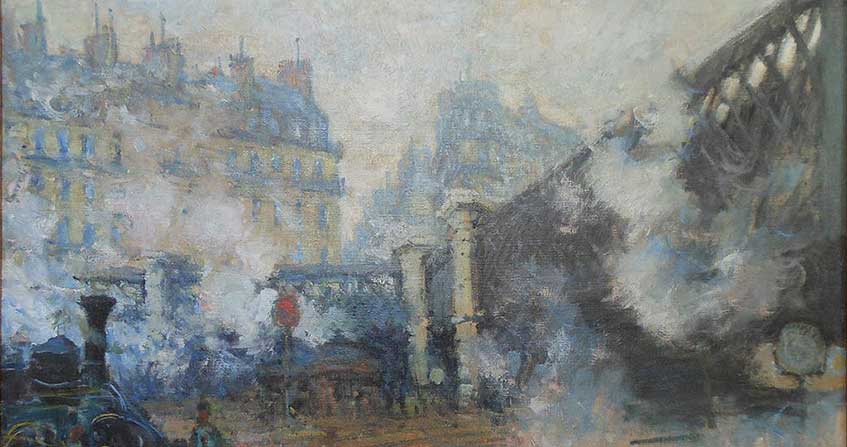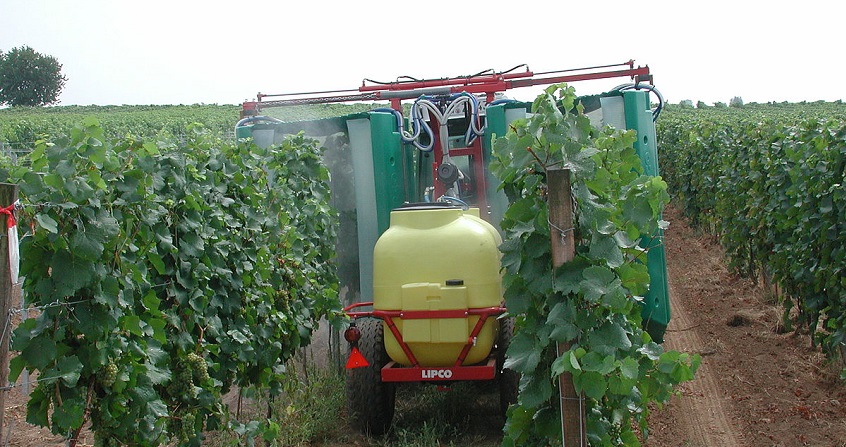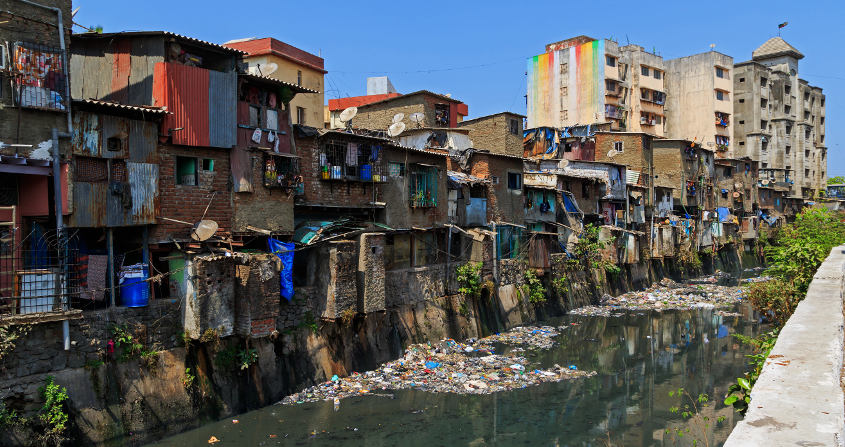What is the ecological impact of light pollution?
PDF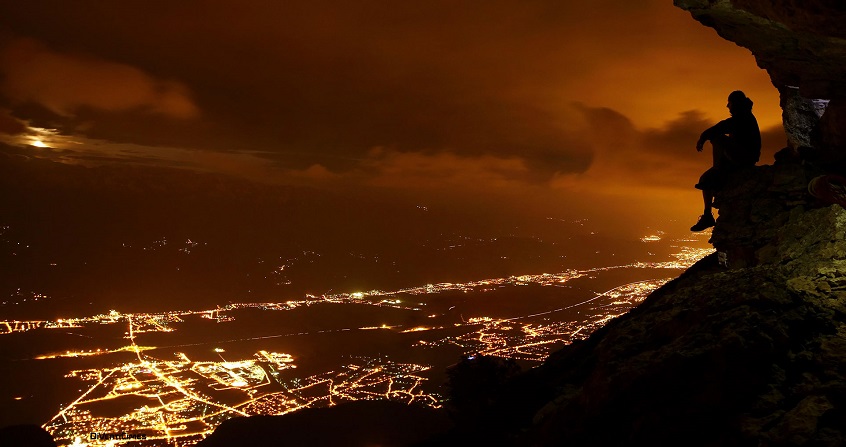
Light pollution is a phenomenon associated with the use of artificial lighting by humans. In fact, it alters the natural cycles of light and alters the illumination of the environment. Through this article, we will consider the origin and extent of light pollution, its impacts on living organisms and ecosystems, as well as the biological mechanisms involved.
1. Light pollution around the world
1.1. What is light pollution?
Light pollution is a phenomenon of anthropogenic origin associated with the development of urbanization and human activities and which involves artificial light. From the astronomer’s point of view and according to a qualitative approach, light pollution refers to artificial light that degrades the quality of the night sky, masks the light of stars and other celestial bodies and limits their study. The astronomer speaks of “astronomical light pollution”. According to a quantitative approach, the International Astronomical Union indicates that, for a clearly defined geographical region, light pollution occurs when the artificial light propagated in the night sky is greater than 10% of its natural luminosity at night.
From the ecologist’s point of view, light pollution refers to artificial light that degrades the cycles of natural light (day/night cycle and seasons), modifies the nocturnal component of the environment, i.e. the illumination of the environment, and consequently impacts behaviour, the biological rhythms and physiological functions of living organisms, as well as ecosystems. Ecologists speak of “ecological light pollution” [1].
1.2. Sources
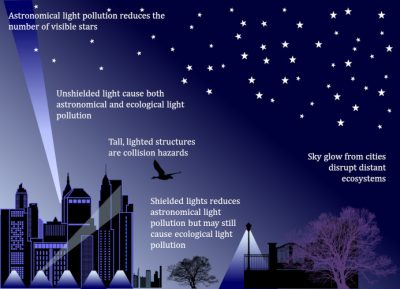
- Public and road lighting, which, in the context of road prevention and anti-crime, is used at luminous intensities that often exceed the minimum requirements.
- Lighting in industrial and commercial buildings, which are frequently over-lit to attract customers and create an attractive and consumer-friendly environment.
- Lighting of car parks and sports centres.
- The exterior and interior lighting of homes that are not regulated by any regulations.
- Vehicle lighting.
In addition, when the lighting is of poor technical quality, when the lighting devices are switched on at unnecessary times of the night or when they are poorly maintained or not maintained, light pollution is amplified.
Finally, weather conditions can influence the extent of light pollution by increasing the diffusion of light into the atmosphere. In urban areas, for example, heavy cloud cover can increase the intensity of light pollution by a factor of 10. These same conditions vary the reflection factors of the illuminated surfaces and therefore the amount of light reflected towards the sky. In dry weather, the reflection factor of artificial surfaces in urban areas is between 0.1 and 0.2, i.e. 10 to 20% of the light received is reflected. For a snow-covered surface, the reflection factor is 0.8.
1.3. A global phenomenon

For the years 2013/2014, light pollution impacts 22.5% of the world’s land surface, 46.9% of the surface area of the United States, 88.4% of the surface area of the European Union and 100% of the surface area of France. As a result, 83.2% of the world population, including 99.7% of the population of the United States, 99.8% of the population of the European Union and 100% of the French population, are affected by light pollution. Finally, 35.9% of the world’s population is no longer able to observe the Milky Way at night and 13.9% of the world’s population is exposed to light pollution such that the visual system cannot adapt to night vision. In reality, the visual system is permanently in day vision [2].
At present, scientists consider that light pollution is one of the fastest growing forms of pollution in the world, growing by an average of 6% per year, and by 10% in European countries [3].
Thus, light pollution is not a local phenomenon. Its scope is global and continues to grow. It already impacts some of the world’s protected areas, particularly regional and national nature parks. A large part of the world’s ecosystems, i.e. a large part of the world’s fauna and flora, is therefore affected.
2. Impacts of light pollution on living organisms
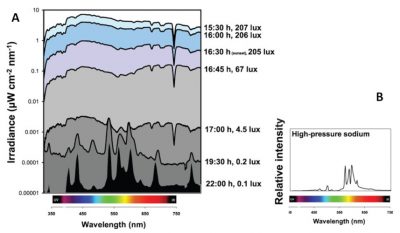
2.1. Changed behaviours
From a behavioural point of view, light pollution leads to attraction/repulsion and orientation/disorientation responses. For example, in small nocturnal mammals, exposure to artificial light causes a repulsive response, i.e. individuals move away from the light source. This behaviour, due to the increased illumination of the environment, probably reflects an increased perception of the risk of being driven out by a predator. On the contrary, in nocturnal insects and migratory birds, organisms that use starlight to move in the dark, exposure to light pollution causes an attractive response, i.e. individuals approach the light source. However, this response can cause disorientation for individuals. Even more problematic, individuals, when approaching artificial lighting, can collide with large lighted structures or dehydrate or even burn themselves in contact with lamps [1].
Light pollution can also affect musculoskeletal and eating habits. This is observed in small nocturnal mammals, which, exposed to light pollution, limit their movements and their search for food, at the risk of seeing their physical condition deteriorate. Thus, in the bushy Darwin’s eared mouse (Phyllotis darwini), individuals exposed to increased environmental illumination reduce their food intake by 15%, provide 40% of the food collected in their shelter, and lose 4.4 g of body weight per night [1].

2.2. Physiological functions and biological rhythms: hypotheses
The impact of light pollution on the biological rhythms and physiological functions of wildlife is still unknown. Most of the current data come from studies in birds. Thus, day birds exposed to light pollution start their activity and singing earlier. In addition, seasonal rhythms are also disrupted as birds exposed to light pollution begin their breeding cycle and moult earlier in the year. A study conducted in 2013 shows that the synthesis of a photosensitive hormone, melatonin, is partially inhibited in birds exposed to light pollution. However, this hormone ensures the synchronization of the body’s different biological rhythms, in birds and mammals alike. It could therefore be involved in the observed lags [5].
In rodents studied in the laboratory, biological rhythms are also modified by light pollution. In addition, light pollution in these animals has been associated with metabolic disorders (glucose intolerance, body weight gain), the genesis of apathetic and depressive behaviours, altered thermoregulation and decreased immune response. In 2016, a study carried out in a small nocturnal primate, the murine microceb (Microcebus murinus), showed that an inhibition of melatonin synthesis could be involved here too [6].
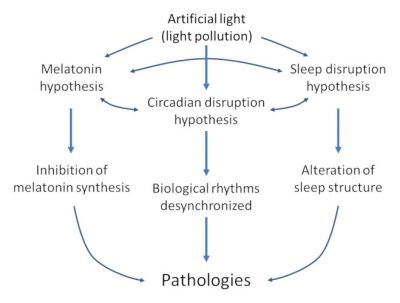
In humans, clinical and epidemiological studies conducted in urban areas and on night work show that light pollution, by altering the day/night cycle, represents a risk to human health [7]. Three mechanisms are advanced to explain how light pollution can affect human health (Figure 5):
- The “Circadian disruption hypothesis“: by stimulating the main internal clock, light pollution desynchronizes it with respect to the day/night cycle.
- Melatonin hypothesis: Light pollution reduces the production and secretion of melatonin. However, melatonin deficiency is accompanied by an alteration of biological rhythms and the loss of its anti-inflammatory, antioxidant, immunostimulant, neuro-protective, cardio-protective and anti-oncotic properties.
- Sleep disruption hypothesis: light pollution, by desynchronizing the main internal clock, could modify the structure of sleep, or even reduce its total duration. However, both the quality and quantity of sleep have been associated with the maintenance of internal homeostasis and are a guarantee of good health.
These three mechanisms are not mutually exclusive. On the contrary, they are probably closely associated and in the long term, by altering the body’s homeostasis, could lead to the genesis of pathologies in humans. In wildlife, it is likely that the same mechanisms are at work.
3. Light pollution and ecosystems
3.1. Unbalanced ecosystems?
At the ecosystem level, light pollution can cause a number of imbalances. In particular, it can modify inter/intra-species competitions, prey/predator balances and the organization of species communities. Indeed, light pollution, by modifying the lighting environment, creates a new ecological niche. However, the strong illumination that characterizes this niche attracts some nocturnal species and repels others. Thus, fast flying bats are able to take advantage of the aggregation of nocturnal insects with streetlights. In particular, for Nilsson’s Serotin (Eptesicus nilssonii), caloric intake is 0.5 kJ/min in peri-urban areas and near streetlights, compared to 0.2 kJ/min in wooded areas. On the other hand, slow-flying bats, which are unsuited to escape from nocturnal raptors, are unable to take advantage of insect aggregations near streetlights. The result is interspecific competition for food, which is at the expense of slow-flying bats. This competition could explain why the number of individuals of fast flying bat species has increased in recent years in Europe while the number of slow-flying species has decreased [1].
In addition, this ecological niche also favours the vision of diurnal species, which can then orient themselves, move around and search for food. These species “colonize”, so to speak, nocturnal habitats exposed to artificial light, compete with nocturnal predators and modify the prey/predator balance. Such behaviours have been observed in spiders, day reptiles and day birds that take advantage of the aggregation of nocturnal insects around streetlights to hunt and the desertion of some nocturnal species to fill a vacant environment. In the opinion of some authors, this desertion from enlightened environments could encourage the colonization of invasive species.
Finally, a study conducted in peri-urban areas showed that artificial lighting changes the composition of terrestrial invertebrate communities. The number of terrestrial invertebrates present directly under artificial lighting is significantly higher than that of invertebrates present at a distance from such lighting and the composition of terrestrial invertebrate communities is significantly different between the two environments. Under the lighting, the communities are mainly composed of predatory and scavenger invertebrates, spiders, carabids, woodlice, ants and amphipods. If carried out on a large scale, such changes could alter the balance and functioning of ecosystems [8].
3.2. Impacts on habitat and species selection
Light pollution could also contribute to habitat fragmentation. The example of nocturnal insects is a perfect illustration of this. Indeed, an artificial light source can attract nocturnal insects within a radius of 400 to 700 metres. However, in urban areas, streetlights are only 30 to 50 metres apart. Illuminated traffic lanes are therefore real artificial barriers that stand on people’s routes. Considering the attraction that artificial light exerts on nocturnal insects, these barriers therefore limit their movements and fragment their habitat [1].
Light pollution could also threaten photosensitive species or individuals, i.e. those with low light tolerance. Light pollution could therefore act as a selection factor and modify the diversity of natural populations. However, it should be recalled that 28% of vertebrates and 64.4% of invertebrates are partially or exclusively active at night, i. e. just as many species that are not or only slightly adapted to the strong illuminations of their environment.
Finally, aquatic organisms and plants, which are sensitive to light like animals, are also threatened by light pollution [9].
In conclusion, light pollution is a phenomenon that is not well known but very real and whose extent is constantly increasing. However, this pollution, by altering the natural cycles of light and the illumination of the environment, is likely to modify the behaviour, physiological functions and biological rhythms of living beings. At the individual level, light pollution can affect orientation and modify locomotor, eating, reproductive and communication behaviour between individuals. At the population and ecosystem level, light pollution acts as a selection factor, modifies inter-species competition, prey/predator balances and fragments habitat. Its impact on ecological communities is therefore real. It is also important to limit and reduce light pollution in order to protect the night sky and biodiversity.
References and notes
Cover image. [Source: © Alain Herrault – Diverticimes]
[1] Rich C. & Longcore T. (2006) Ecological consequences of artificial night lighting. Island Press.
[2] Falchi F., Cinzano P., Duriscoe D., Kyba C.C.M., Elvidge C.D., Baugh K., Portnov B.A., Rybnikova N.A. & Furgoni R. (2016) The new world atlas of artificial night sky brightness. Science Advances 2, e1600377.
[3] Hölker F., Moss T., Griefahn B., Kloas W. & Voigt C.C. (2010) The darkside of light: a transdisciplinary research agenda for light pollution policy. Ecology and Society 15, 13.
[4] Gaston K. J., Bennie J., Davies T. W. Hopkins J. (2013) The ecological impacts of night time light pollution: a mechanistic appraisal. Biological Reviews of the Cambridge Philosophical Society 88, 912-927.
[5] Dominoni D.M., Goymann W., Helm B. & Partecke J. (2013) Urban-like night illumination reduces melatonin release in European blackbirds (Turdus merula): implications of city life for biological time-keeping of songbirds. Frontiers in Zoology 10, 1-10.
[6] Le Tallec T., Théry M. & Perret M. (2016) Melatonin concentrations and timing of seasonal reproduction in male mouse lemurs (Microcebus murinus) exposed to light pollution. Journal of Mammalogy, 1-8.
[7] Haim A. & Portnov B.A. (2013) Light pollution as a new risk factor for human breast and prostate cancers. Springer.
[8] Davies T.W., Bennie J. Gaston K.J. (2012) Street lighting changes the composition of invertebrate communities. Biology Letters 8, 764-767.
[9] Hölker F., Wolter C., Perkin E.K. & Tockner K. (2010) Light pollution as a biodiversity threat. Trends in Ecology & Evolution 25, 681-682.
The Encyclopedia of the Environment by the Association des Encyclopédies de l'Environnement et de l'Énergie (www.a3e.fr), contractually linked to the University of Grenoble Alpes and Grenoble INP, and sponsored by the French Academy of Sciences.
To cite this article: LE TALLEC Thomas (January 5, 2025), What is the ecological impact of light pollution?, Encyclopedia of the Environment, Accessed April 13, 2025 [online ISSN 2555-0950] url : https://www.encyclopedie-environnement.org/en/life/what-is-the-ecological-impact-of-light-pollution/.
The articles in the Encyclopedia of the Environment are made available under the terms of the Creative Commons BY-NC-SA license, which authorizes reproduction subject to: citing the source, not making commercial use of them, sharing identical initial conditions, reproducing at each reuse or distribution the mention of this Creative Commons BY-NC-SA license.





